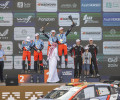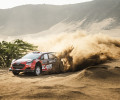WRC - The 2017 World Rally Car - Technical Issues
Michel Nandan, Team Principal at Hyundai Motorsport, talks about some of the changes in the Technical Regulations for 2017 as the team looks forward to another successful season in the FIA World Rally Championship.

Three seasons into its FIA World Rally Championship comeback and Hyundai Motorsport is firing on all cylinders. This year, the Korean manufacturer was closer than it has ever been to claiming an FIA World Rally Championship title. Two wins and a string of podiums clinched second in the Manufacturers’ Championship in the penultimate round of the series, Thierry Neuville is on the brink of claiming second in the Drivers’ Championship and the battle for third is also open for Hayden Paddon at the final event in Australia.
2017 sees Hyundai committed to the dawn of an exciting new era in the Championship, with more powerful, dynamic looking and throaty new cars ready to hit special stages across the globe. After months of test and development, the 2017 Hyundai i20 WRC will finally break cover on 1 December at the Monza Rally Show ahead of its debut competitive outing on the season-opening Rallye Monte-Carlo in January next year.
In the last of a series of features about the all-new 2017 World Rally Cars, Michel Nandan, Team Principal at Hyundai Motorsport, talks about some of the changes in the Technical Regulations and the impact they will have.
The 2017 World Rally Cars will have an active centre differential, what exactly does this mean, why has this been changed and what does it mean in terms of set-up between special stages?
Michel Nandan:
“This was a change requested by the manufacturers. With the active centre differential the stress on the driveshafts will be less, so in terms of durability it’s a positive point. As far as what will change, it will be possible to set up the handling of the car a bit better, and it will also be easier to adapt the handling depending on the road surface and conditions.”
What does the active centre differential mean as far as drivability is concerned, being that the front and rear differentials are still passive?
Michel Nandan:
“It is true that the front and rear differentials are still mechanical, so passive diffs, but the fact you have an active centre differential will help drivability and handling, especially in and out of corners. It will help the driver go through and out of a corner more smoothly, so yes it will change something and help the drivers’ skills.”
The cars will be wider next year, affecting the transmission and suspension. What are the consequences of this?
Michel Nandan:
“The cars will have more stability in corners. The widening has essentially been done for the look of the car, but the consequence is that we will have more stability in corners.”
Will the suspension travel be increased on the 2017 WRC cars?
Michel Nandan:
“From the point of view of the regulations there is no change, but on the front of the car there is total freedom of the kinematic points, which of course is giving a bit more freedom for the damper lengths; not really [suspension] travel, but it will help to optimise the gravel suspension.”
New openings are allowed on the front and rear fenders, what does it means in terms of cooling? Will they be used only for brake cooling?
Michel Nandan:
“The openings in the fenders are mainly there to help brake cooling and evacuate the heat generated by the brakes so yes, this will help because it was one of the main problems of a rally car that you could only bring some air into the front.”
Overall, what do you think the changes, the dynamics, will bring for Hyundai and the fans in the FIA World Rally Championship?
Michel Nandan:
“The most obvious thing will be the general look of the car because there is more freedom on the bodywork, more aero and the car looks really more aggressive, so this will be the first thing the fans will see and enjoy because the cars will look really really spectacular.”
Michel Nandan talks about some of the technical changes on the 2017 World Rally Car:

 Facebook
Facebook Twitter
Twitter






